
Summarize Content With:
Summary
This article is your starting point for building a Voice AI agency in 2025. You’ll learn how companies of all sizes – from independent entrepreneurs to established call centers – are adopting AI-powered voice technology to transform the way they connect with their customers.
We’ll break down exactly what a Voice AI agency does, the tools you’ll need to set up shop, and how smart voice assistants and virtual receptionists can streamline everyday interactions.
Inside, you’ll find a clear, step-by-step guide on designing workflows, training your AI systems, making sure everything stays compliant with regulations, and handling the common obstacles that come up along the way.
If you’ve been thinking about automating customer calls or are curious how AI contact center software could open up new income streams, this guide will walk you through it all – so you can launch your agency with clarity and confidence.
Let’s be real – whenever people hear the term call center, they usually picture a noisy room packed with agents reading the same lines over and over again. For a long time, that was exactly how things worked. Endless cold calls, long wait times, and plenty of frustrated customers. It hardly felt innovative.
But that old picture is changing faster than anyone expected.
With the rise of artificial intelligence, companies can now use AI-powered tools that handle calls in ways that feel surprisingly personal. Whether it’s an AI receptionist greeting customers, a voice assistant booking appointments, or an automated system following up on leads, modern AI can take on repetitive tasks without sounding flat or mechanical.
That’s a big reason why 2025 is shaping up to be such a pivotal year for Voice AI agencies. Businesses of all sizes – from neighborhood shops to large-scale BPOs – are actively looking for solutions that help them cut costs, speed up service, and improve the customer experience. And more often than not, they’re ready to invest in technology that delivers real results.
If starting a Voice AI agency has been on your mind, you’re in good company. Many entrepreneurs are discovering that offering call automation isn’t just a smart way to build a business – it’s also a chance to be part of a major shift in how companies connect with people.
In this guide, I’ll walk you through exactly what you need to get started, so you can build your agency step by step and position yourself as a trusted expert in this growing field.
Introduction: What is a Voice AI Agency?
Before you decide if this is the right path for you, it’s worth taking a moment to understand what a Voice AI agency actually does – because it goes far beyond simply selling software or setting up a chatbot.
A Voice AI agency helps companies streamline and upgrade the way they handle calls by blending artificial intelligence with their existing workflows. Rather than having human agents manage every single conversation, businesses can deploy smart voice systems that take care of repetitive tasks quickly and naturally.
Here’s another way to look at it:
- An AI Call Assistant can welcome callers, answer everyday questions, pre-qualify leads, and transfer conversations to the right department when necessary.
- An AI Receptionist can manage scheduling, record messages, and pick up incoming calls any time of day – without needing a break or time off.
- And AI Call Center Software can handle outbound campaigns from start to finish, follow up automatically, and track responses in real time.
- At its core, your role as a Voice AI agency is to help clients choose the right technology, set up effective workflows, train the AI on their business information, and continuously monitor how well it’s performing. Over time, you’ll fine-tune these systems so conversations stay smooth and accurate.
Companies are eager to adopt these tools for several reasons:
- Shorter wait times for customers
- Lower costs compared to hiring large teams
- Consistent, reliable service
- The ability to grow without huge overhead
Simply put, a Voice AI agency becomes a trusted partner that guides businesses through the process of adding intelligent automation to their phone interactions – so they can stay ahead and deliver a better experience to every caller.
Why 2025 is the Year for Voice AI Agencies
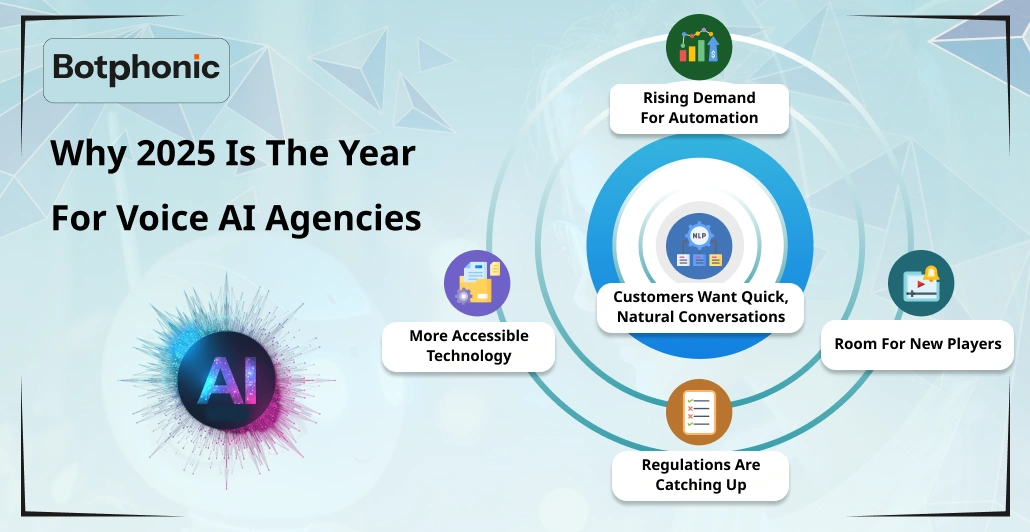
If you’ve been asking yourself, “Why should I start now?” – you’re not alone. Plenty of entrepreneurs wonder the same thing before jumping in.
The reality is, Voice AI isn’t just a trend waiting around the corner. It’s already reshaping how companies interact with their customers, and 2025 is shaping up to be the most promising year yet to get involved.
Here’s what’s driving this momentum:
Rising Demand for Automation
More companies are actively looking for ways to bring down costs without compromising service. Whether it’s an online retailer or a medical practice, organizations across industries are adopting AI-powered contact centers to improve efficiency and stay competitive.
Customers Want Quick, Natural Conversations
People have grown tired of clunky menus and endless hold music. Today, they expect smooth, human-sounding interactions – whether they’re calling to schedule an appointment or ask about a product. Modern AI voice systems have finally reached a level where they can deliver that experience reliably.
More Accessible Technology
Not long ago, setting up an AI call assistant required a big investment and specialized technical teams. Now, no-code and low-code platforms make it possible to create and customize workflows without a background in software development. That levels the playing field for new agencies.
Regulations Are Catching Up
Concerns about compliance used to hold many businesses back. These days, AI platforms often come with built-in tools to handle permissions, opt-outs, and data privacy requirements, giving clients peace of mind.
Room for New Players
Although AI has gained traction in call centers and BPOs, it’s still early days. Smaller and mid-sized businesses are just beginning to explore what AI can do. That leaves a wide-open space for new agencies to carve out their niche and establish themselves as trusted partners.
If you’ve been waiting for the right moment to jump in, this is it. 2025 isn’t just another year – it’s when Voice AI goes fully mainstream, and the companies that embrace it early will have a clear advantage.
Steps to Start Your Voice AI Agency
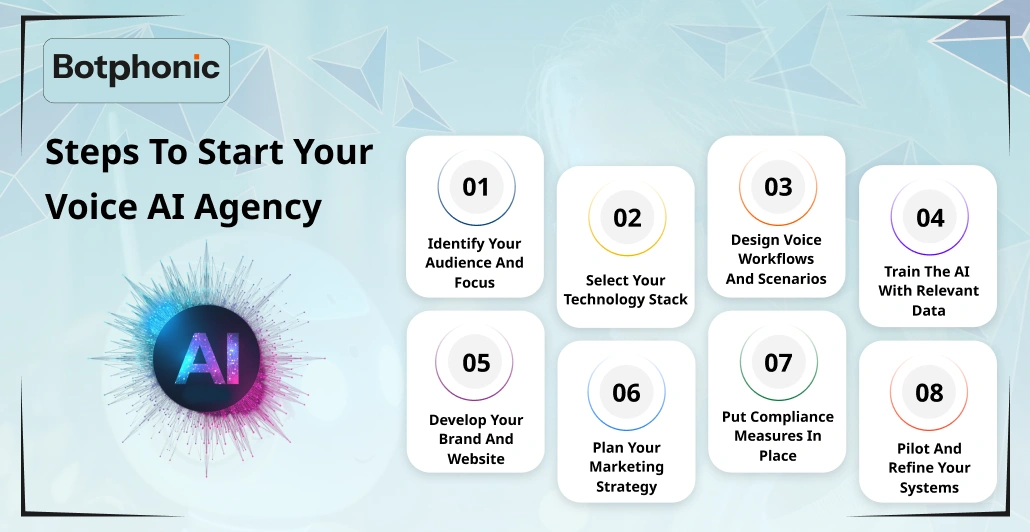
Launching your own Voice AI agency might feel overwhelming at first glance, but breaking it down into clear steps makes the process much easier to tackle. Here’s a straightforward roadmap to help you move from idea to launch:
1. Identify Your Audience and Focus
Start by deciding which types of businesses you want to serve. Will you help local service providers that need an AI receptionist? Or target larger call centers ready for full-scale automation? Defining your audience will help you tailor your solutions and choose the right tools.
2. Select Your Technology Stack
The core of your agency is the software you’ll use to build and manage AI voice workflows. Explore various AI call center platforms and automation tools. Prioritize systems with capabilities like natural language understanding, speech synthesis, call analytics, and compliance features. Test a few options so you can confidently recommend the best fit.
3. Design Voice Workflows and Scenarios
Once you’ve chosen your tools, map out the conversations your AI will handle. These could include:
- Answering common product or service questions
- Screening and qualifying leads
- Running outbound campaigns
- Booking appointments
Create detailed workflows for each scenario so your AI assistants are ready for real-world interactions.
4. Train the AI with Relevant Data
AI systems rely on examples to learn. Gather real scripts, FAQs, and customer interactions from your clients and use them to train your models. The better your training data, the more natural and accurate the conversations will feel.
5. Develop Your Brand and Website
Build a professional website that explains what you offer, showcases success stories, and demonstrates the benefits of AI-powered voice solutions. Position your agency as an expert that can help businesses improve service, save money, and stand out.
6. Plan Your Marketing Strategy
Think about how you’ll reach potential clients. You might run targeted ads, share educational content, or offer free demos to show how your solutions work. Blogs, guides, and video tutorials can help establish your credibility in the industry.
7. Put Compliance Measures in Place
Before launching, confirm that your workflows meet relevant regulations like TCPA, GDPR, or HIPAA, depending on your clients’ industries. Make sure you build in consent prompts, opt-out options, and secure data handling practices.
8. Pilot and Refine Your Systems
Run test calls internally or with pilot clients. Listen carefully for any awkward phrasing or inaccuracies, and adjust as needed. Once you’re confident in the results, you’re ready to start offering your services publicly.
Starting a Voice AI agency requires commitment and careful planning, but if you follow these steps, you’ll be prepared to deliver solutions that businesses genuinely want – and need.
Tools You’ll Need
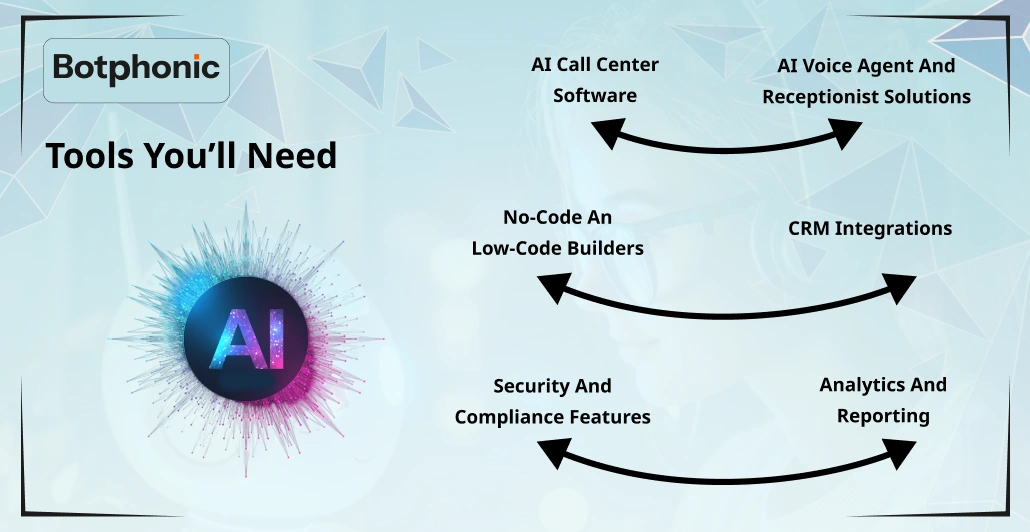
A question that comes up often when people think about launching a Voice AI agency is, “Which tools do I actually have to invest in?”
The good news is, you don’t have to build your systems from the ground up. There are plenty of established platforms designed to help you create and run AI-powered voice workflows without needing a large technical team.
Below are some essential categories of tools you should consider:
AI Call Center Software
This is the foundation of your setup. A reliable call center platform lets you create conversation flows, deploy AI call assistants, and track performance over time. For instance, Botphonic provides a complete solution that covers call routing, live analytics, and monitoring dashboards, so you always know exactly how your systems are operating.
AI Voice Agent and Receptionist Solutions
These tools are designed to handle natural, back-and-forth conversations with customers. They combine speech recognition, language understanding, and voice synthesis to create a more lifelike experience. With Botphonic, you can customize dialogue scripts, fine-tune tone, and add multiple languages if your clients serve diverse audiences.
No-Code and Low-Code Builders
If you don’t have a background in programming, no-code builders make it easy to design workflows through visual interfaces instead of writing scripts manually. Botphonic offers intuitive tools that help you set up and adjust processes quickly, even if you’re not a developer.
CRM Integrations
Most businesses will want their AI systems to sync with their existing CRM platforms. Look for solutions that connect easily with tools like Salesforce, HubSpot, or Zoho so that all call records, notes, and follow-ups stay organized in one place.
Security and Compliance Features
Data privacy is critical in any customer interaction. You’ll need software that can manage consent notices, opt-out options, call recording disclosures, and secure data storage. Botphonic has built-in compliance capabilities that help you meet standards like TCPA, GDPR, and industry-specific regulations.
Analytics and Reporting
Having clear insights into performance is just as important as having the AI itself. Good reporting tools help you track key metrics – such as average call time, conversion rates, customer sentiment, and response accuracy – so you can make improvements as you go. Botphonic’s reporting dashboard makes it easy to review and share these insights with your clients.
You don’t have to gather all these tools right away, but knowing what’s available will help you build a system that’s dependable, efficient, and ready to scale as your agency grows.
Challenges You Might Face (And How to Overcome Them)
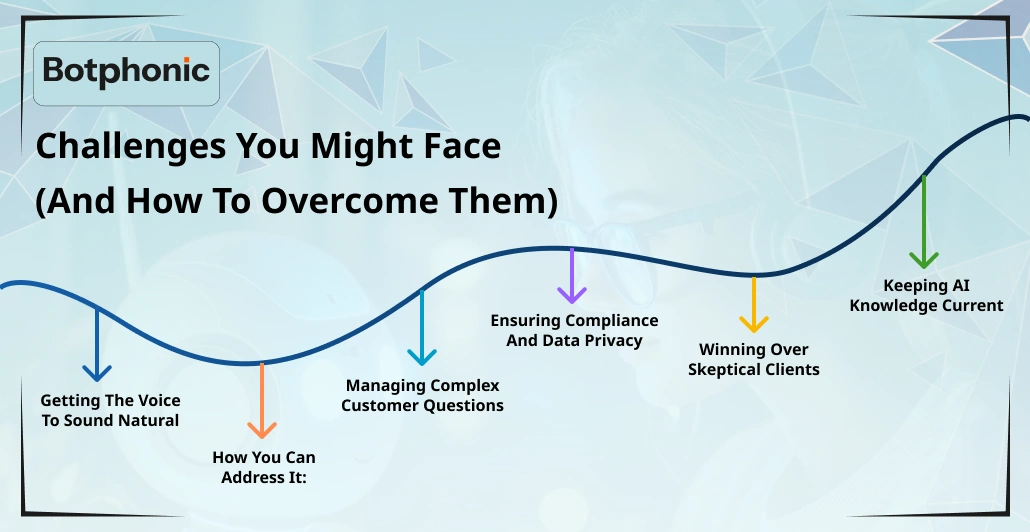
Building a Voice AI agency can be incredibly rewarding, but like any business, it comes with a few common obstacles. The good news is that most of these challenges are predictable – and if you plan ahead, you’ll be well-prepared to address them as they come up.
Getting the Voice to Sound Natural
One of the first things your clients will notice is how the AI sounds on the phone. If the voice feels monotone or overly robotic, it can immediately put people off and make conversations feel awkward.
How you can address it:
Choose a platform – like Botphonic – that focuses on delivering clear, expressive speech. Always test voice samples in real-world scenarios to hear how they hold up in practice before deploying them to customers.
Managing Complex Customer Questions
AI systems do well with routine tasks, but sometimes callers have issues that need more context or subtle judgment.
How you can address it:
Train your AI models on a variety of examples, including detailed product info, sample objections, and realistic scenarios. Botphonic lets you feed your system robust data sets so it can learn to handle more nuanced questions effectively.
Ensuring Compliance and Data Privacy
When you’re dealing with customer calls, privacy regulations are serious business. Different regions have their own rules about consent, data handling, and recording disclosures.
How you can address it:
Build compliance into your process from the start. Incorporate clear consent prompts and easy opt-out options, and keep data security top of mind. Botphonic comes with integrated compliance tools to help you stay aligned with legal requirements like TCPA and GDPR without extra hassle.
Winning Over Skeptical Clients
Not every business owner will be comfortable letting AI take over customer interactions. Some will worry about losing a personal touch or damaging their brand reputation.
How you can address it:
Share real-world examples and case studies that show how effective AI voice agent can be. Offer live demos or trial periods so clients can experience the benefits themselves. Clear communication and transparency go a long way toward building trust.
Keeping AI Knowledge Current
Over time, business details change – pricing updates, new services, evolving customer expectations. If your AI doesn’t stay up to date, it can start giving out old or inaccurate information.
How you can address it:
Schedule regular reviews to check call logs and refresh training data. Botphonic makes this process straightforward by giving you a central place to track performance and roll out updates quickly.
Even though these challenges might seem intimidating, each one has a clear, practical solution. With the right tools and a thoughtful approach, you’ll be ready to deliver Voice AI services that feel professional, responsive, and genuinely helpful.
Benefits of Launching a Voice AI Agency
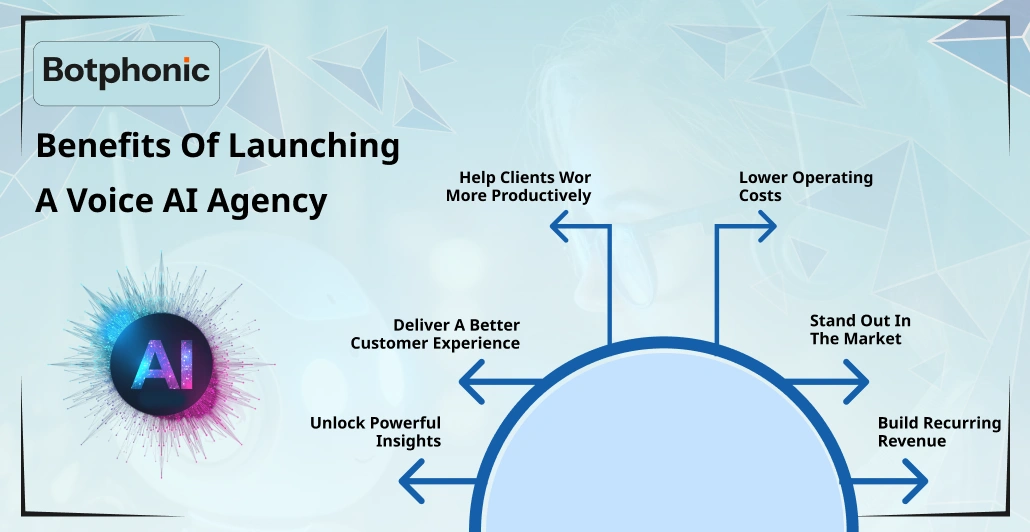
Once you’ve set everything in motion, the advantages of operating a Voice AI agency become obvious. No matter if your clients are small local businesses or established companies with thousands of customers, you’ll be delivering something they truly value: a faster, more efficient way to connect with people.
Help Clients Work More Productively
AI voice systems can field countless calls at once without any breaks or downtime. That means your clients won’t need to worry about understaffed shifts or long queues. Solutions like Botphonic make it simple to automate everyday tasks – like booking appointments, qualifying leads, or handling common questions – so their teams can focus on work that requires a human touch.
Lower Operating Costs
Staffing a large call center isn’t cheap. Between salaries, training, and management, expenses add up quickly. With AI call center platforms, companies can bring those costs down dramatically. Even better, they can scale their operations up or down easily, without major logistical challenges. For many organizations, that flexibility is reason enough to invest in automation.
Deliver a Better Customer Experience
Nobody enjoys being put on hold or repeating the same information to multiple agents. AI call assistants can offer fast, accurate responses on the first try. With Botphonic, you can design voice workflows that feel friendly and personalized – so customers feel understood, not frustrated.
Stand Out in the Market
Voice AI is still gaining traction, especially among small and mid-sized businesses. By positioning yourself as one of the early providers in this space, you’ll set your agency apart from competitors and attract clients who want to stay ahead of industry trends.
Unlock Powerful Insights
Traditional call centers often struggle to track what’s working and what isn’t. AI solutions capture every conversation, making it easy to spot patterns, evaluate scripts, and see which offers drive engagement. Botphonic’s reporting tools help you present these insights clearly so clients can make informed decisions.
Build Recurring Revenue
Unlike one-off projects, Voice AI services require ongoing monitoring, updates, and improvements. That means you’ll create steady income streams as you continue to support and fine-tune your clients’ systems over time.
Put together, these benefits explain why so many entrepreneurs are moving into this space. You’ll be offering a solution that’s not only in high demand but also backed by proven, scalable technology – setting you up for long-term growth.
Final Thoughts
The way companies interact with customers has changed faster in the last few years than in the previous few decades. What used to take massive call centers and dozens of employees can now happen seamlessly through AI-powered voice tools.
If you’ve been considering starting a Voice AI agency, there’s no better time than now. Businesses everywhere are searching for reliable partners who can help them cut costs, improve service, and keep up with rising customer expectations.
You don’t have to tackle everything alone. Platforms like Botphonic are built to help you handle the entire process, from setting up smart voice assistants to making sure you stay compliant with regulations and understand exactly how your systems are performing. Whether you begin with a single client or plan to scale quickly, you’ll have the resources you need to move forward confidently.
The most important step is simply to get started. Even if you launch small – testing workflows and learning what works best – you’ll be ahead of the curve. While others are still debating whether AI will transform the industry, you’ll already be proving it.
If you’re ready to see what’s possible, this is your moment. The technology is here. The demand is growing. And your agency could be exactly the partner businesses are searching for next.

